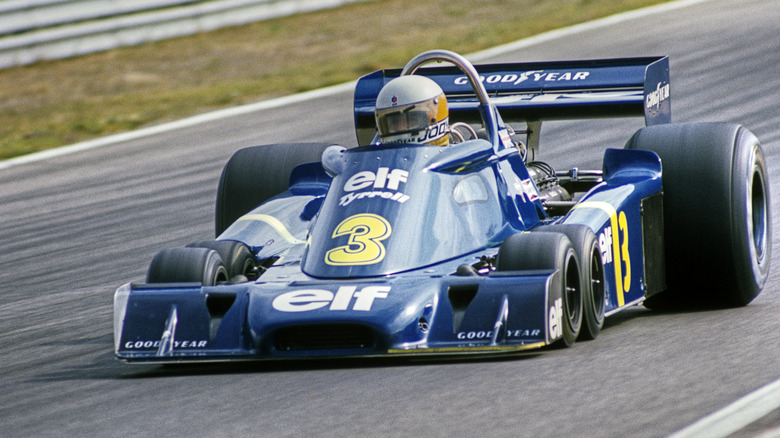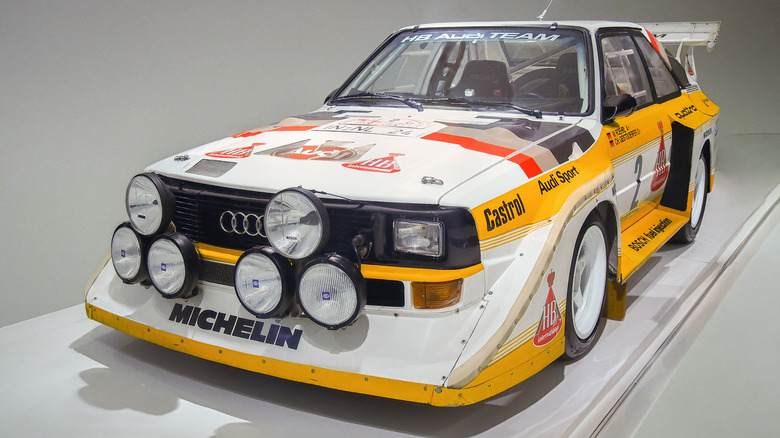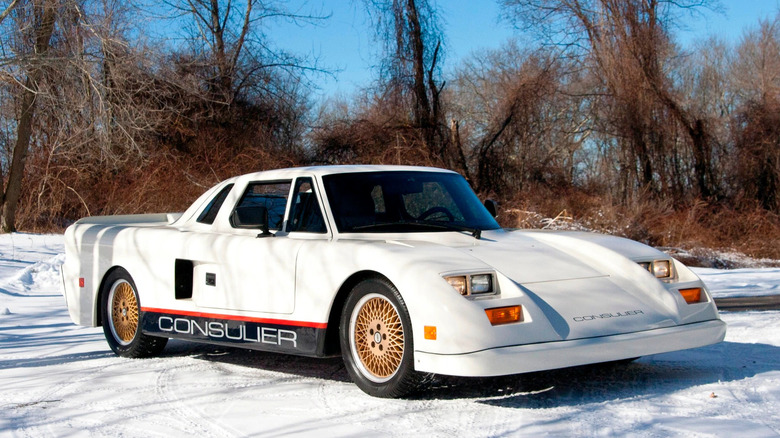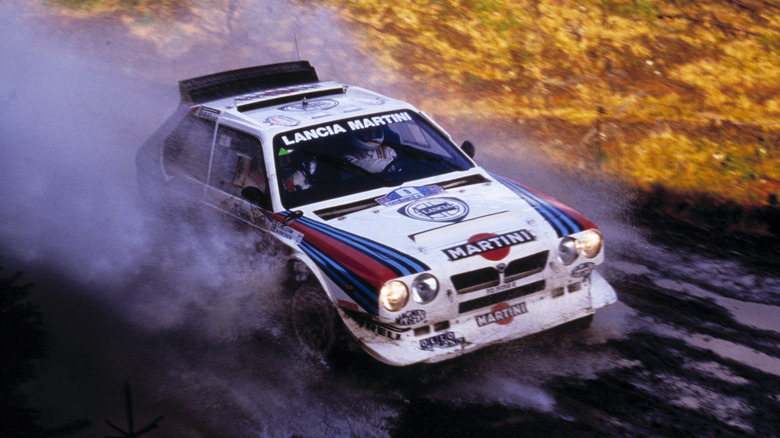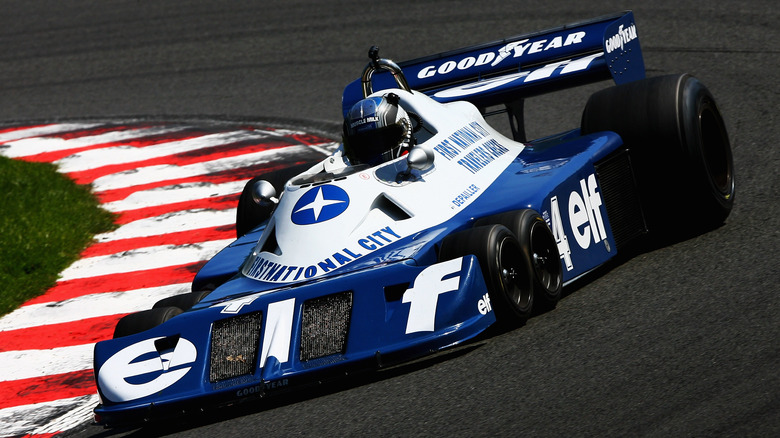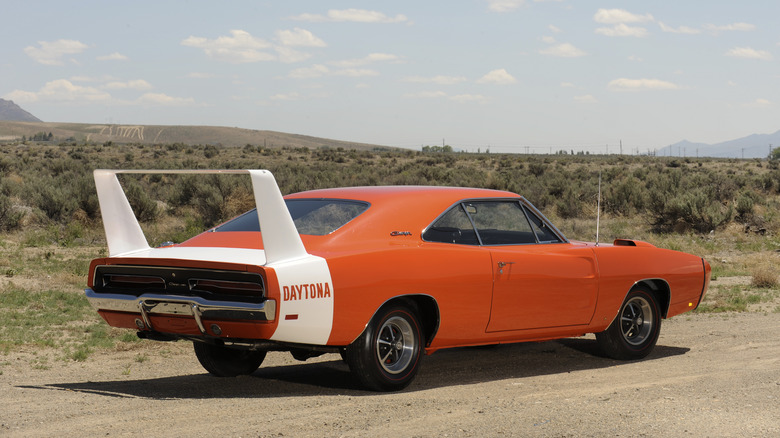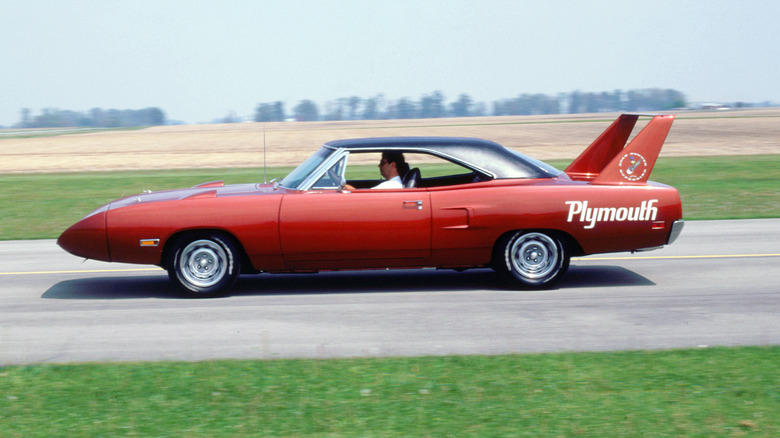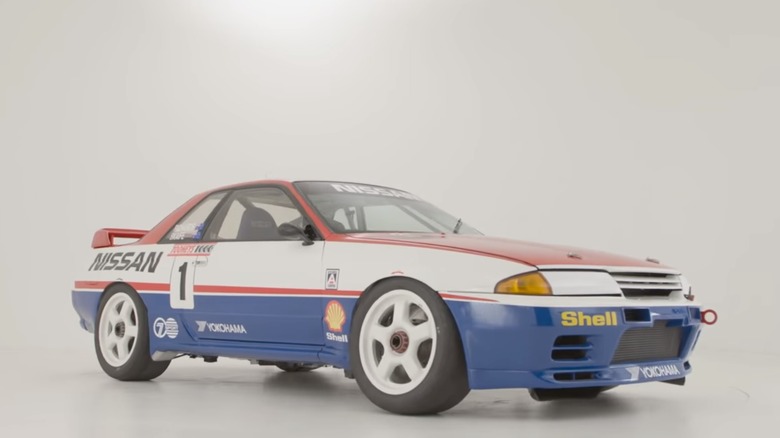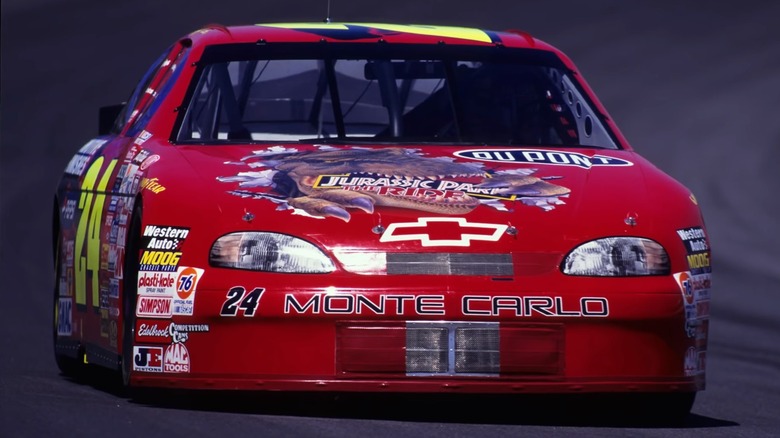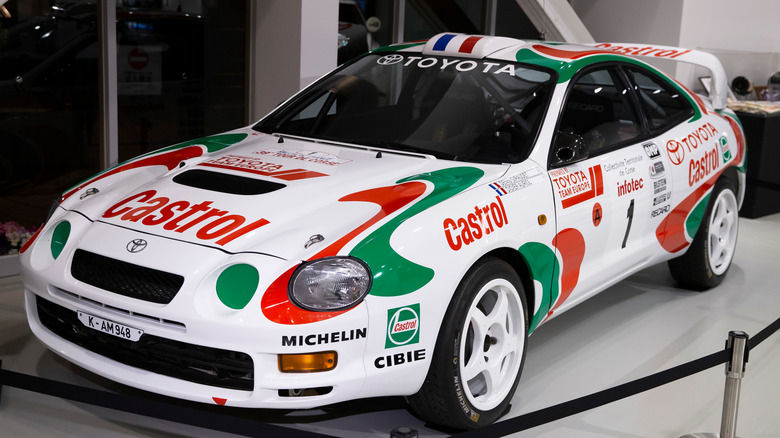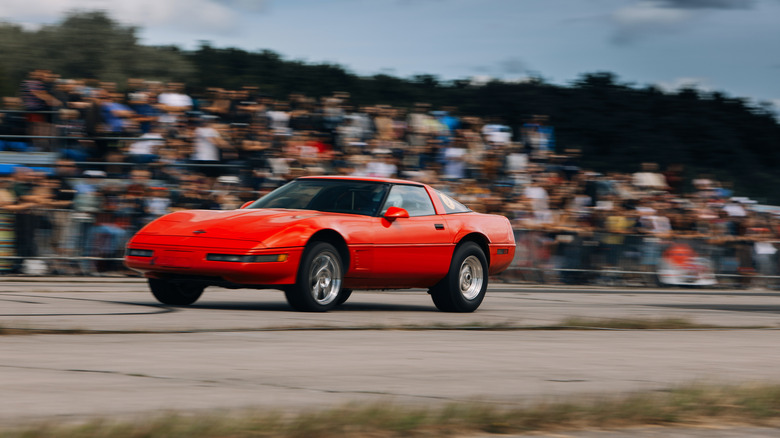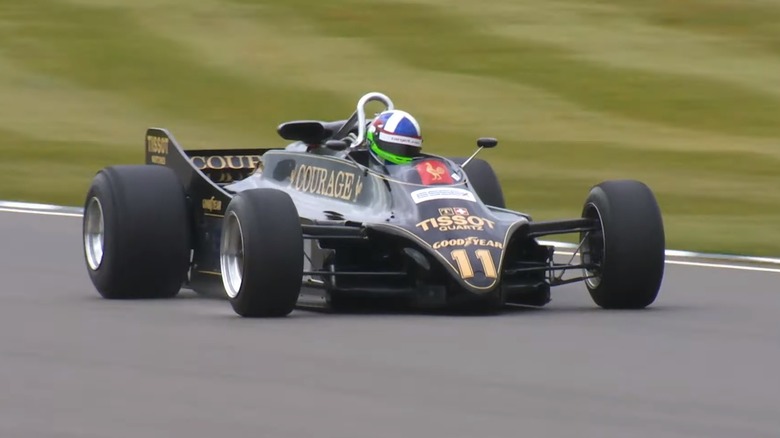The Gnarliest Racecars That Have Gotten Banned
Innovation is one of the key factors that every motorsport discipline needs to stay competitive. Without designers creating groundbreaking cars, races would quickly become dull, and new motorsport legacies could never be created. However, new technical advances are not always welcomed by race organizers. Some of these innovations are seen as too effective, giving one team an unfair advantage over their opponents. Some are simply considered too dangerous, with the potential gain in speed not worth the added risk to the lives of competitors, fans, or both.
Whatever the reason they were booted out of racing, there are plenty of cars that got banned before they could really demonstrate their true potential. From rallying to NASCAR, every discipline has its fair share of controversial car bans, leaving fans to wonder how the sport would have progressed if these exceptional race cars were allowed to continue competing. A few managed to find a second life in another racing series or as collectors' items, but most of them simply ended up consigned to the history books.
Audi Sport Quattro S1
One of the most iconic World Rally Championship cars ever made, the Quattro's dominant run was cut short by the banning of the Group B category after a series of fatal crashes. The Quattro originally made a name for itself in the 1983 and 1984 seasons, where Hannu Mikkola and Stig Blomqvist respectively took the drivers' title behind the wheel of one. The Group B Quattro S1 made its debut in 1984 and continued competing until the category was banned in 1986.
The original Quattro is regarded as the first rally car to prove that four-wheel drive was not only competitive in rallying but with the right setup, gave drivers a significant advantage over the competition. As more power was added over the years, it was also becoming an incredibly difficult car to control, with Evo noting that the Quattro S1 E2 displays "a powerful physicality and bare-knuckle brutality that [we] haven't experienced in any other rally car." In its final form, the Quattro made close to 600 horsepower, but it was arguably too much, and drivers simply couldn't control it anymore. The fatal Group B crashes of 1986 were unfortunately proof that rally cars had gotten out of control, although it's worth noting that none of these fatalities involved the Quattro. After a largely unsuccessful attempt at entering a car under Group A regulations in 1987, Audi quit rallying altogether in 1988 and has never returned to the Championship since.
Mosler Consulier GTP
The Mosler Consulier GTP might not have looked good, but it was brutally fast. Developed by Warren Mosler, a former hedge fund executive who set up his own car company in 1985, the Consulier GTP was unlike any other American car of its era. It sported a monocoque chassis, a lightweight carbon-kevlar body, and a small 2.2L four-cylinder engine that made 175 horsepower in stock form. The original idea was to make a production run of up to 200 road cars per year, while the racing variant of the car competed in IMSA events. However, after two dominant wins at Lime Rock and Laguna Seca in 1991, IMSA slapped the car with a large weight penalty before eventually banning it from competition entirely.
To add to Mosler's woes, the road car struggled to find buyers due to its high asking price and questionable looks. It's thought that only 83 examples of the car were ever built before it was axed in 1996. If that wasn't enough, Warren Mosler had also publicly attacked the editors of Car and Driver magazine, who had claimed that a stock Corvette was faster than the Consulier GTP. Mosler claimed that the magazine had used a worn-out example of his car for testing, but the negative publicity that the back-and-forth generated no doubt exacerbated the car's sales failure. Examples are rare to find today, but one appeared on Bring A Trailer in 2018, selling for $55,000.
Lancia Delta S4
The most notorious Group B casualty, the Lancia Delta S4 was responsible for one of rallying's most tragic incidents ever. At the Tour de Corse in 1986, Henri Toivonen lost control of his Delta S4, flying off the road and into some trees. One of the trees ruptured the car's gas tank, causing a fire, and both Toivonen and his co-driver Sergio Cresto burned to death in their seats before they had a chance to escape. The exact circumstances surrounding the crash are still mysterious since there were no spectators or race marshals close to the scene at the time. The only footage of the accident was filmed from so far away that it's impossible to get a clear picture of what caused Toivonen to suddenly lose control.
Within hours of the accident, the sport's governing body had ruled that Group B cars would be banned from 1987. The Delta S4's unpredictability and unbridled power had made it too much of a hazard to continue competing, despite the fact that it was a very successful car when it was in good form. After being banned from rallying, some Delta S4s ended up as autocross vehicles, with the Works car that won the 1986 Monte Carlo Rally taking second place in the European Autocross Championship in 1988, and winning the title in 1989.
Tyrrell P34
The only six-wheeled car to ever compete in Formula 1, the Tyrrell P34 initially proved to be very competitive. Almost every other car on the grid at the time was using the same engine, transmission, and tires, making it tricky to find a truly game-changing advantage. Derek Gardner, the designer of the P34, went back to an old idea he'd had when working on an IndyCar design — perhaps six wheels were better than four. The idea turned out to work very well, as the two smaller front wheels cut down on lift and allowed Gardner to reduce the amount of front aerodynamics needed on the car. This effectively gave the car a power boost over the rest of the grid, to the tune of around 40 horsepower extra.
The car showed great potential and took home its first win after just four races, although eventually, its unique tire layout caused its competitiveness to wane. Tire supplier Goodyear had continued to develop its full-size tires throughout 1976 but had not worked on the P34's smaller front tires, leading to a grip imbalance between the front and rear of the car. The car was retired in favor of a more conventional four-wheeled design the following year. A few years later, in the early '80s, the use of six-wheeled cars was banned altogether, bringing an underwhelming end to what could have been a revolutionary development in Formula 1.
Dodge Charger Daytona
It's become an American motorsport icon, but the Dodge Charger Daytona's actual NASCAR racing career was cut short by an infamous and controversial ban. The Daytona took the original Dodge Charger and equipped it with a more powerful V8 engine, a nose cone, and a huge rear wing. The aero kit was seen as ludicrous when it first debuted, but it gave the Daytona a huge increase in downforce, allowing the car to reach speeds that simply weren't possible before. It became the first stock car to reach 200 mph, and quickly began to win races.
Alongside its Plymouth-badged cousin, the Superbird, Chrysler Corporation ended up fielding 23 of the 40 cars that competed in the 1970 Daytona 500 and took up six of the top eight places in the race. Such dominance couldn't be tolerated for long, and new legislation banned the cars from competing outright from 1971. Smaller, less powerful engines were mandated, making the outrageous aerodynamics all but useless, and bringing an end to the so-called "aero wars."
Plymouth Superbird
The Plymouth Superbird was built to rival the Dodge Charger Daytona, and like the Daytona, only got a very short time in the limelight before it was unceremoniously banned. It was originally conceived as a way to entice Richard Petty back to Plymouth after he'd left for Ford, with Plymouth executives flying out to Petty's house to ask him what it would take to get him back. His answer was simple – he wanted a car that was as revolutionary as the Dodge Charger Daytona, and so the Superbird was born.
Petty did indeed return to racing with Plymouth the following year and saw huge success, but NASCAR was having none of it. The Superbird was legislated out of the competition alongside the Charger Daytona, ushering in an era of NASCAR that would no longer be defined by faster and faster cars. As a stock car, the Superbird was also sold to the public throughout its time on the track, and today the road-going cars are highly sought after among collectors. WWE legend John Cena is among the lucky owners to have been able to get his hands on one.
Nissan Skyline GT-R R32
The Nissan nicknamed "Godzilla" was so far ahead of the competition in the Australian Touring Car Championship that the sport's governing body rewrote part of the rulebook to specifically exclude it. Entered under Group A regulations, the Skyline GT-R R32 wiped the floor with its competition, to the point where plenty of local fans actually came to despise it. Before the car was unveiled in 1990, Nissan had never won the Australian Touring Car Championship, but that same year, the manufacturer took the title for the first time. It repeated its success for the following two years before the rules were changed to mandate V8 engines in every race car. As a famously six-cylinder car, the GT-R was essentially blocked from competing.
Although the GT-R R32 Group A race car was already a force to be reckoned with at home in Japan, the engineers behind the Aussie racing version claim that theirs is vastly superior thanks to the extensive redevelopment the car underwent to be competitive Down Under. The engine was reworked, along with the suspension, transmission, wheels, and more, with most replacement parts sourced from domestic Australian suppliers to keep costs down. Under Group A rules, a small number of Aussie R32 road cars had to be sold, and today they're even more valuable than the regular GT-R R32 thanks to their additional race-developed enhancements.
Chevrolet T-Rex Monte Carlo
The "T-Rex" Monte Carlo, developed by Hendrick Motorsports, holds the unfortunate title of being one of the most promptly-banned cars in motorsport history. It was only declared legal for a single race before its innovative design was banned by NASCAR for being too good. The car debuted at the Lowe's Motor Speedway all-star event in 1997, with Jeff Gordon behind the wheel. After cruising to a decisive victory, the car was scrutinized by race inspectors, who in the end had to agree that the car was legal under the current season's rulebook. However, the team was reportedly asked not to use the car again at any NASCAR-sanctioned event.
Hendrick Motorsport has argued that the car would never have been banned were it not for the fact that superstar Jeff Gordon left his competition so far behind in that single race. Strangely enough, the unique setup of the #24 car was originally discovered partially by accident, as Ray Evernham explained that the idea of lowering the front to increase the aerodynamics was not a deliberate one, but rather an experiment during testing. The team only fully realized why the car had been so successful after the race had finished, but by that point, it was too late.
Toyota Celica GT-Four
A controversial WRC season in 1995 saw Toyota get banned altogether after employing an illegal cheat to get around new turbocharging restrictions. After seeing several years of (legitimate) success with the Celica in the seasons prior, a new safety ruling by the FIA enabled Toyota to come up with what was described by one official as the "most ingenious thing" he'd seen in his career. The new rule saw restrictor plates fitted to every car's turbo to limit its power, but Toyota devised a way to make fit the plate in a manner that made it effectively useless.
The workaround made the part look legal when it was taken out for inspection, but allowed extra airflow into the engine when it was installed, giving the car a power bump that added an extra 50 horsepower. It's not known exactly what happened to make race regulators aware of the cheating, and some have suggested that a whistleblower could have been involved. Either way, as soon as the team was found out, the car was banned effective immediately, and every Toyota driver that season had their points taken away. The team behind the cheat was also banned from competing in the 1996 season.
Chevrolet Corvette C4
The Chevy Corvette C4 proved itself to be very good at SCCA Showroom Stock GT racing. So good, in fact, that every other manufacturer in the series threatened to walk away if Chevy wasn't banned. Porsche, in particular, was instrumental in getting the C4 out of the series, as it had previously enjoyed a dominant run in the years leading up to the Chevy's debut. Things changed in 1985, as former series competitor John Powell recalled in an interview with Hagerty: "The Corvette beat Porsche 29–0 from 1985 to 1987."
After rivals including Porsche issued the series with an ultimatum, race management caved in, and the C4 was given the boot. However, it wasn't all bad news, as the Corvette racing teams eventually formed a separate racing series called the Corvette Challenge. This new, rival series ended up attracting big-name sponsorships and allowed for a $1 million season purse, which at the time was very unusual. ESPN even ended up striking a deal for TV coverage of the Corvette series, giving the upstart championship a wider reach than the original series the car had been kicked out of.
Lotus Type 88
One of the many innovations of Lotus founder and racing genius Colin Chapman, the Lotus Type 88 Formula 1 car essentially had two chassis, to get around regulations that limited the amount of downforce a car could generate. One chassis was made from carbon fiber and Kevlar and housed the engine and cockpit. The second chassis was stiffer and managed all the aerodynamic downforce, giving the car an advantage over its single-chassis competition.
Unfortunately for Chapman, his innovative design never got the chance to show its potential. It was immediately banned upon its race debut, being disqualified during practice for allegedly breaking the rules. Chapman argued that it simply bent the rules rather than broke them, but it was no use, and the car was disqualified again at the following two races. Eventually, Lotus had to revert to using previous-generation Type 87 cars for the remainder of the season.
